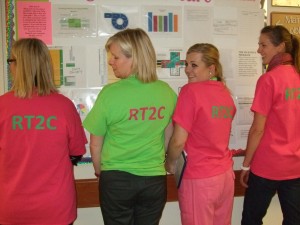
RH staff on 3S review the Releasing Time to Care dashboard to discuss the topics of the day, which could be hand-washing audits, reducing patient falls or progress on tidying up the nurses’ station to improve the work environment, resulting in the “Well Organized Ward” or WOW! Nurse Educator Norm Greenaway leads this ward meet, but this role is shared by the team.
Engagement is the extent to which our staff are committed both emotionally and intellectually to excellence at VCH. Engagement is less about what we do and more about how we do it. This series celebrates the great work in safety and engagement on our front lines.
At Richmond Hospital and Squamish General Hospital, safety and engagement are part of every day activity. They are also integral to “Releasing Time to Care,” a pilot program underway at the rural hospital and on three units at Richmond Hospital: 2 South, 3 North and 3 South.
Releasing Time to Care (RT2C) is designed to do just that – release clinical staff from onerous, time-consuming functional tasks so that they can focus on the important work: patient care. Using concepts similar to “Lean,” the grass-roots program engages staff in their own environment where they can bring forward real issues for discussion and resolution. Issues can be large or small, but resolving them relies on safe, open conversation about the issues that affect the quality and efficiency of the unit. Ideas are generated by the team. Priorities are identified by the team. Responsibilities are shared by members of the team.
“This is how it should be,” says Felicia Laing, Quality & Patient Safety Project Manager. “How the team can work best together is best decided by the team itself.” Along with LEAN consultants Lorelei Grosser, Ruby Gill and Tom Majek, Laing provides overall education and support for the pilot sites at Squamish General and Richmond Hospitals. “The work is at different stages of development in each unit, but the staff engage in developing a vision statement, vote on priorities for the unit and volunteer to make positive change by taking on a bit of the work toward change.”
RT2C is rooted in having the right person doing the right job; the right communication at the right time, having the right equipment in the right place, having the right processes for the right results, and having the right people making the right decisions. “This means that staff spend a lot of time engaged in conversation. On 3 South, for instance, staff have daily ‘team meets’ of just 5 to 10 minutes right in the hallway, led by any one of the staff. They use a white board that’s been turned in to a visual display of the things that are important to them – hand washing scores or patient falls, for instance.” This is safety and engagement working together.
“The staff champions have done an amazing job getting their peers engaged,” adds Laing. “This type of initiative can’t be successful without peer-to-peer support.”
And for managers, this is a great example of how the People First Safety & Engagement Action Plans can be integrated and achieved through initiatives such as Releasing Time to Care.
If you have a story you would like to share about your team’s success, please contact me and get your story in VCH News!

